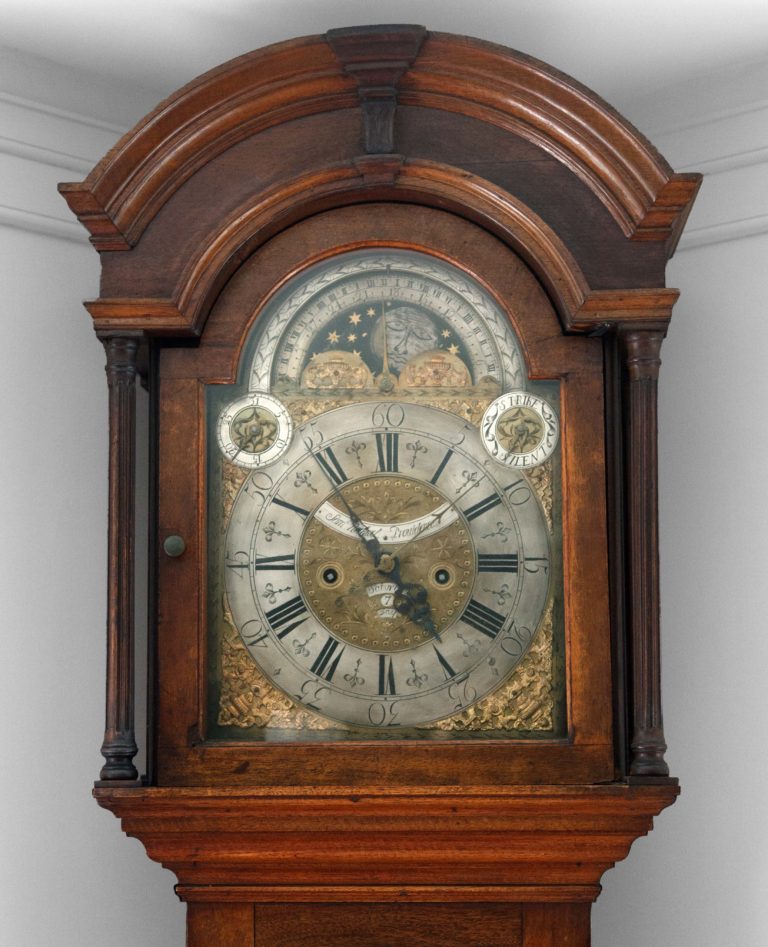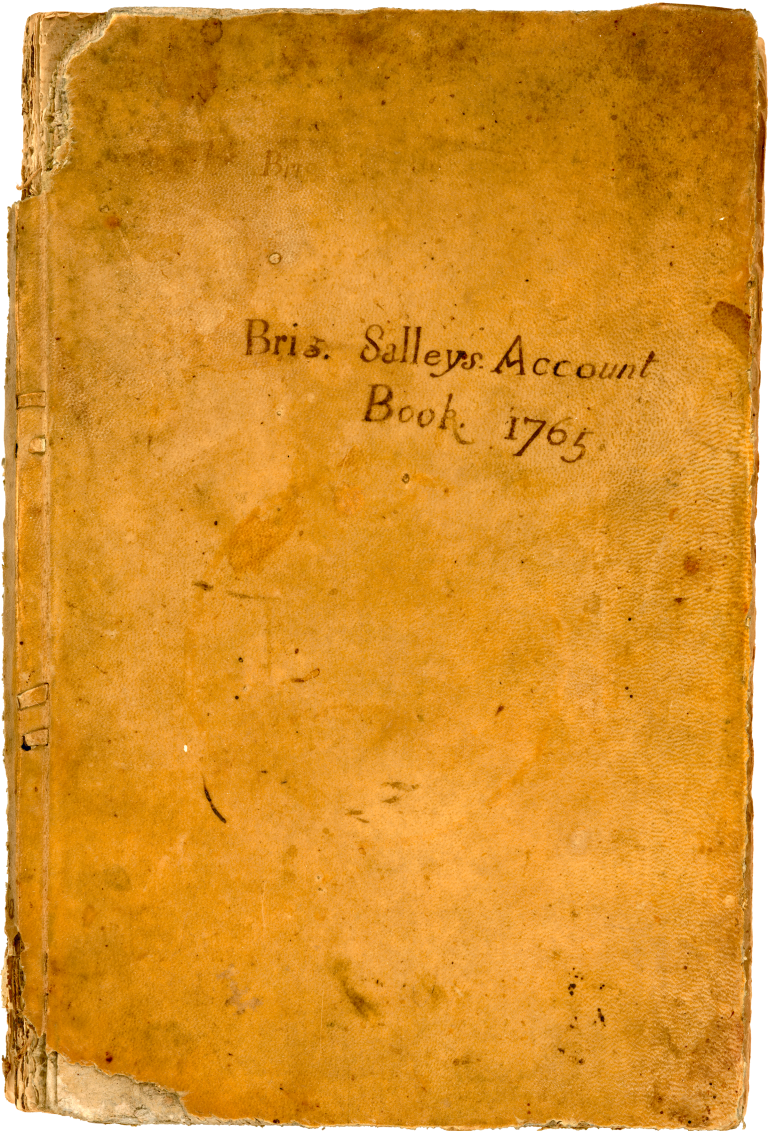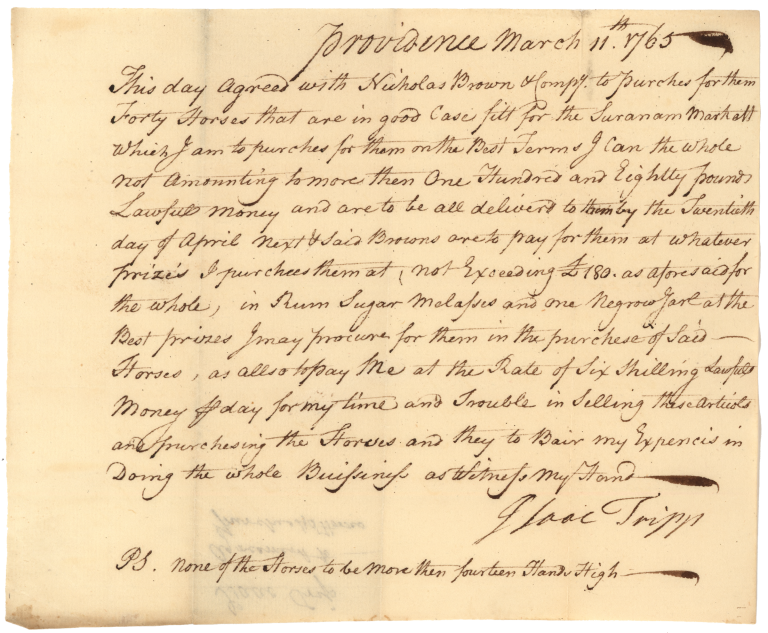Introduction
In 2003, Brown University President Ruth J. Simmons appointed a Steering Committee on Slavery and Justice to investigate and issue a public report on the University’s historical relationship to slavery and the transatlantic slave trade. Since that time, the Committee, which includes faculty, students, and administrators, has met periodically in an office on the second floor of University Hall, the oldest building on the Brown campus. In the corner of the office stands an antique clock. A silver plaque on the cabinet identifies it as “The Family Clock of Admiral Esek Hopkins.” Built in the 1750s by a local craftsman, Samuel Rockwell, the clock was donated to Brown in the 1850s by Hopkins’ granddaughter. Such artifacts and heirlooms abound on the campus, and it took several months for Committee members to notice the clock or to recognize its significance.

An antique grandfather clock, a bequest of the family of Admiral Esek Hopkins, stands in University Hall. Esek Hopkins served not only as first commander in chief of the U.S. Navy but also as captain of the slave ship Sally, the one-hundred-ton brigantine owned by Nicholas Brown and Company that sailed from Providence to West Africa on a disastrous slaving expedition in 1764, the year of the College’s founding.
Though less celebrated than his older brother Stephen, a colonial governor and signer of the Declaration of Independence, Esek Hopkins is a well-known figure in Rhode Island history. A Providence ship captain, he served as the first commander in chief of the United States Navy during the American Revolution. After the war, he was elected to the state legislature. Like his brother, he was a strong supporter of Brown, then known as the College of Rhode Island, serving as a member of the Board of Trustees from 1782 to 1802. His memory is enshrined today in several public sites in Providence, including the Esek Hopkins Middle School, Esek Hopkins Park (which includes a statue of him in naval uniform), and Admiral Street, where his old house still stands.

The account book for the slave ship Sally, 1764–1765, records the ship’s transactions on the African coast.
There is another aspect of Esek Hopkins’ story, unmentioned on any of the existing memorials. In 1764, the year that the College of Rhode Island was founded, Hopkins sailed to West Africa in command of a slave ship, a one-hundred-ton brigantine called the Sally. The Sally was owned by Nicholas Brown and Company, a partnership of four brothers, Nicholas, John, Joseph, and Moses Brown. Prominent Providence merchants, the Browns were also important benefactors of the College, playing a leading role in relocating the school from its original home in Warren, Rhode Island, to its current location in Providence. (In 1804, the College of Rhode Island changed its name to Brown University, in recognition of a gift from Nicholas’ son, Nicholas Jr.) There was nothing unusual about a slave ship departing from Rhode Island. Rhode Islanders dominated the North American share of the African slave trade, mounting over a thousand slaving voyages in the century before the abolition of the trade in 1807 (and scores more illegal voyages thereafter). The Sally’s voyage was deadlier than most. At least 109 of the 196 Africans that Hopkins purchased on behalf of the Browns perished, some in a failed insurrection, the balance through disease, suicide, and starvation. The records of the venture, from the fitting out of the ship in August 1764 to the sale of surviving captives on the West Indian island of Antigua fifteen months later, are housed in a library on the Brown campus, though few have troubled to look at them, at least until recently.
We shall return to the voyage of the Sally, an episode of considerable significance in the lives of the Brown brothers, three of whom seem never again to have invested directly in transatlantic slaving voyages. But let us return first to the clock. What should the University do with it, now that we know more about its origins? Is it appropriate to display it? Should we remove the plaque honoring Esek Hopkins? Attach another plaque? We are obviously speaking metaphorically here, but the underlying questions could not be more direct. How are we, as members of the Brown community, as Rhode Islanders, and as citizens and residents of the United States, to make sense of our complex history? How do we reconcile those elements of our past that are gracious and honorable with those that provoke grief and horror? What responsibilities, if any, rest upon us in the present as inheritors of this mixed legacy? The Brown University Steering Committee on Slavery and Justice represents one institution’s confrontation with these questions.
The Committee’s Charge
The president’s charge to the Committee had two dimensions. Our primary task was to examine the University’s historical entanglement with slavery and the slave trade and to report our findings openly and truthfully. But we were also asked to reflect on the meaning of this history in the present, on the complex historical, political, legal, and moral questions posed by any present-day confrontation with past injustice. In particular, the president asked the Committee “to organize academic events and activities that might help the nation and the Brown community think deeply, seriously, and rigorously about the questions raised” by the national debate over reparations for slavery. Reparations, she noted, was a highly controversial subject, presenting “problems about which men and women of good will may ultimately disagree,” but it was also a subject on which Brown, in light of its own history, had “a special obligation and a special opportunity to provide thoughtful inquiry.” In her letter of charge and in a public statement following the announcement of the Committee’s appointment, the president stressed that the Committee would not determine whether or how Brown might pay monetary reparations, nor did she expect it to forge a consensus on the reparations question. Its object, rather, was “to provide factual information and critical perspectives to deepen understanding” and enrich debate on an issue that had aroused great public passion but little constructive public dialogue.1
Overview of Activities
The Steering Committee has endeavored to fulfill this charge. Members of the Committee, assisted by other Brown faculty as well as by undergraduate and graduate student researchers, gathered information about Brown’s past, drawing on both published sources and various historical archives. The Committee also sponsored more than thirty public programs, including scholarly lectures, panel discussions, forums, film screenings, and two international conferences exploring the experience of other societies and institutions that have grappled with legacies of historical injustice. In all, we entertained more than a hundred distinguished speakers, ranging from Professor John Hope Franklin, who discussed his tenure as chairman of One America, President Clinton’s short-lived national commission on race, to Beatrice Fernando, a slavery survivor from Sri Lanka, who spoke on the problem of human trafficking today.2

The economy of colonial Rhode Island depended on the provisioning trade with Caribbean plantation colonies. On March 11, 1765, the Brown brothers contracted Isaac Tripp, a local merchant, to acquire forty horses “fitt for the Suranam Markett” on their behalf, for a sum not exceeding £180. With money in short supply, the brothers paid for the horses in goods, including rum, sugar, molasses, and “one Negrow Garl.”
The Steering Committee also organized programs and activities beyond the University’s gates. Committee members addressed community groups and participated in workshops for local teachers and students. A museum exhibition about the Sally, mounted by undergraduate research students working with the Committee, is currently touring public libraries across the state. The exhibition, “Navigating the Past: The Voyage of the Slave Ship Sally, 1764–1765,” has also been exhibited at the John Brown House, the historic home of one of the ship’s owners, and at the Museum of Antigua and Barbuda in St. John’s, Antigua, the final destination of the surviving captives from the ship. Members of the Committee also collaborated with the Choices Program, a curricular development group affiliated with Brown’s Watson Institute for International Studies, to write and publish a high school curriculum, “A Forgotten History: The Slave Trade and Slavery in New England.” With the support of the office of President Simmons, the Committee was able to donate copies of the curriculum to every high school history and social studies classroom in Rhode Island.3
This is an effort designed to involve the campus community in a discovery of the meaning of our past. . . . Understanding our history and suggesting how the full truth of that history can be incorporated into our common traditions will not be easy. But, then, it doesn’t have to be.
Structure of the Report
The Report that follows represents the culmination of the Committee’s work. It contains three sections, reflecting the different elements of the president’s charge. The first focuses on history, exploring different aspects of the University’s relationship to slavery. This section reveals the complicity of many of the University’s founders and benefactors in slavery and the slave trade, and outlines some of the direct benefits that accrued to the University. Yet it also seeks to do more. Brown’s formative decades coincided with many of the signal events in America’s tortuous racial history: the peak of the transatlantic slave trade and the appearance of a popular movement decrying the trade as criminal; the birth of a new nation, dedicated to the proposition that all people were created equal and endowed with certain inalienable rights, and the emergence of racist ideologies insisting that people were not equally created or endowed; the gradual abolition of slavery in the northern states and the rapid expansion of the institution in the South. Brown University was shaped by all of these developments, and members of the campus community, including students, vigorously debated their meaning and significance. We are not the first members of the Brown community to confront our University’s historical complicity in slavery and the slave trade or to debate our own responsibilities in light of it.
The second section looks beyond Brown to the problem of retrospective justice around the world. How have other institutions and societies dealt with the legacies of gross injustice — not only of slavery, but also of genocide, “ethnic cleansing,” and other crimes against humanity? One of the signature developments of the last sixty years, and of the last twenty years in particular, has been the emergence of an international consensus on the importance of confronting traumatic histories, as well as the development of a variety of mechanisms for doing so, including international tribunals, truth commissions, national apologies, the erection of public memorials, and a wide array of monetary and non-monetary reparations programs. While this history has spawned a voluminous scholarly literature, it has had relatively little bearing on the slavery reparations debate in the United States, which has, at least in recent years, focused narrowly on the issue of monetary reparations. Our object in this section of the Report is to bring this comparative, global experience to bear on the American case, and on the predicament of our University in particular. What is a crime against humanity? Where does the concept come from, and what does it entail? What legacies do such crimes leave, and what mechanisms exist to redress them? Do all historical injuries merit remedy? When does it become too late to redress an injustice? The section includes extensive notes for individuals interested in pursuing particular issues and questions in greater detail.
“Are we wrong, are we merely superstitious, if we hold that those early leaders, passing through our American colleges, have left a portion of themselves behind?” President Faunce asked. “It is not only ivy that clings to ancient walls — it is memories, echoes, inspirations. The very stones cry out a summons… ”
In the final section, we turn to the slavery reparations debate in the United States, examining the contours of the current controversy as well as the issue’s deeper historical roots. In keeping with the president’s charge, our object is not to resolve the reparations debate but rather to illuminate questions and contexts that are often overlooked in public discussion today. What actually happened when slavery was abolished, first in northern states like Rhode Island, and later in the South? What legacies did slavery bequeath to the nation, and what attempts were made to redress those legacies, both in the immediate aftermath of abolition and subsequently? What forms has the movement for slave redress taken at different historical moments, with what results? In short, where did the current reparations movement come from? This section too contains extensive notes, elaborating particular issues and offering suggestions for further reading.
As should by now be clear, the Steering Committee does not intend this Report as the last word on the subject, but rather as the first words in a dialogue that we hope will continue on our campus and in our nation. Yet in the course of our research, we also reached certain conclusions. We share these at the end of the Report, accompanied by a series of recommendations directed specifically at Brown University.
A Summons
One of the Committee’s first actions was to invite anyone interested in our efforts to submit questions, comments, and criticisms. Hundreds of individuals availed themselves of the opportunity, some of them members of the Brown community, most of them not. The temper of the letters varied widely, but one question arose again and again: Why would Brown launch such an undertaking? Why risk opening chapters of the past that are, inevitably, controversial and painful? We hope that the Committee’s work — the programs we organized and the Report that follows — will suffice as an answer. But there is an even simpler answer: Brown is a university. Universities are dedicated to the discovery and dissemination of knowledge. They are conservators of humanity’s past. They cherish their own pasts, honoring forebears with statues and portraits and in the names of buildings. To study or teach at a place like Brown is to be a member of a community that exists across time, a participant in a procession that began centuries ago and that will continue long after we are gone. If an institution professing these principles cannot squarely face its own history, it is hard to imagine how any other institution, let alone our nation, might do so.4
You disgust me, as you disgust many other Americans. Slavery was wrong, but at that time it was a legal enterprise. It ended, case closed. You cite slavery’s effects as being the reason that black people are so far behind, but that just illustrates your ignorance. Black people, here and now, are behind because some can’t keep their hands off drugs, or guns, or can’t move forward, can’t get off welfare, can’t do the simple things to improve their life. . . . They don’t deserve money, they deserve a boot in the backside over and over until they can find their own way. . . . Can your ignorant research, and can Ruth Simmons, too.
As it happens, one of the most eloquent expositions of the idea of the university came from a Brown president, Rev. William Faunce, in a 1914 sermon celebrating the University’s sesquicentennial. “Are we wrong, are we merely superstitious, if we hold that those early leaders, passing through our American colleges, have left a portion of themselves behind?” Faunce asked. “It is not only ivy that clings to ancient walls — it is memories, echoes, inspirations. The very stones cry out a summons.” He continued: “Have we entered so new a world that we have no further connection with the generation in which these colleges were born? To think so would be to show ourselves without the sense of either historic continuity or moral obligation.” It is in that spirit, and with a deep sense of historic continuity and moral obligation, that we offer this Report.5
This seems an effort fraught with potential for conflict, embarrassment, and discord. But few issues in U.S. society are so important, and you deserve great credit for taking on this important work. And your efforts — if they are rigorous and critical and comprehensive — could serve as a model for a broader discussion throughout our society of the residue of slavery.
